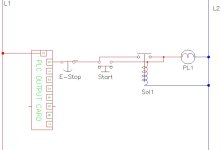First let me explain what we're doing. The E-stop circuit is hardware based. We have some very large pumps that normally go through a controlled shutdown where the discharge valve closes first (very slowly to eliminate pressure surges). When the valve is confirmed closed, the pump motor stops. We have E-stop buttons locally at the motors to instantly stop the motor and close the valve quickly for safety reasons. None of the E-stop logic goes through the plc.
However, the client wanted to be able to E-stop the pump using SCADA, which means initiating an E-stop command through software. The reason for wanting to issue the remote E-stop is in case the normal stop sequence fails. Suppose the discharge valve limit switch fails to activate when the valve closes. The operator would then issue the remote E-stop to kill the pump motor. This is a convenience issue, not a safety issue.
The plc output will activate the same hardware based E-stop circuit as the local mushroom. The integrator is telling the client that's some kind of violation of a code he can't specifically quote, stating it's an inappropriate use of E-stop. I know NFPA-79 (10.7.2.3)says Emergency stop switches shall not be flat switches or graphic representations based on software applications.
First of all, is NFPA-79 considered a code? If not, is there anything in the NEC or elsewhere that prohibits ISSUING an E-stop command through a plc, in addition to the normal safety E-stop local buttons? Maybe we should just call it something else besides E-stop, like Fast-Stop or Instant-Stop. But that doesn't change the fact that we're still going to activate the same E-stop circuit as the local mushroom.
However, the client wanted to be able to E-stop the pump using SCADA, which means initiating an E-stop command through software. The reason for wanting to issue the remote E-stop is in case the normal stop sequence fails. Suppose the discharge valve limit switch fails to activate when the valve closes. The operator would then issue the remote E-stop to kill the pump motor. This is a convenience issue, not a safety issue.
The plc output will activate the same hardware based E-stop circuit as the local mushroom. The integrator is telling the client that's some kind of violation of a code he can't specifically quote, stating it's an inappropriate use of E-stop. I know NFPA-79 (10.7.2.3)says Emergency stop switches shall not be flat switches or graphic representations based on software applications.
First of all, is NFPA-79 considered a code? If not, is there anything in the NEC or elsewhere that prohibits ISSUING an E-stop command through a plc, in addition to the normal safety E-stop local buttons? Maybe we should just call it something else besides E-stop, like Fast-Stop or Instant-Stop. But that doesn't change the fact that we're still going to activate the same E-stop circuit as the local mushroom.



